Draft Goods and Services Tax Ruling
GSTR 2014/D1
Goods and services tax: motor vehicle incentive payments
-
Please note that the PDF version is the authorised version of this draft ruling.This document has been finalised by GSTR 2014/1.There is a Compendium for this document: GSTR 2014/1EC .
| Contents | Para |
|---|---|
| PROPOSED LEGALLY BINDING SECTION: | |
| What this Ruling is about | |
| Background | |
| Ruling | |
| Worked examples | |
| Date of effect | |
| NOT LEGALLY BINDING SECTION: | |
| Appendix 1: Explanation | |
| Appendix 2: Summary of GST consequences for specific incentive payments | |
| Appendix 3: Your comments | |
| Appendix 4: Detailed contents list |
Preamble
| This publication is a draft for public comment. It represents the Commissioner's preliminary view about the way in which a relevant taxation provision applies, or would apply to entities generally or to a class of entities in relation to a particular scheme or a class of schemes.
You can rely on this publication (excluding appendixes) to provide you with protection from interest and penalties in the following way. If a statement turns out to be incorrect and you underpay your tax as a result, you will not have to pay a penalty. Nor will you have to pay interest on the underpayment provided you reasonably relied on the publication in good faith. However, even if you don't have to pay a penalty or interest, you will have to pay the correct amount of tax provided the time limits under the law allow it. |
What this draft Ruling is about
1. This draft Ruling explains the Commissioner's view on the goods and services tax (GST) consequences of incentive payments made by motor vehicle manufacturers, importers and distributors (manufacturers) to motor vehicle dealers (dealers).
2. The draft Ruling seeks to provide practical guidance to the motor vehicle industry following the decision of the Full Federal Court in AP Group Limited v. Federal Commissioner of Taxation (2013) 214 FCR 301; [2013] FCAFC 105; 2013 ATC 20-417 (AP Group). As a result of the Court's decision, the previous ATO view concerning the GST consequences of motor vehicle incentive payments can no longer be maintained.[1]
3. The draft Ruling makes some general observations relevant to the GST consequences of motor vehicle incentive payments and provides specific guidance on common types of incentive payments through worked examples. In preparing this draft Ruling, the Commissioner has consulted with the motor vehicle industry to identify common payment types. The Commissioner welcomes any submissions identifying other types of motor vehicle incentive payments that should be included in the final Ruling.
4. The draft Ruling only applies to the class of entities that make or receive incentive payments in the motor vehicle industry. This draft Ruling is therefore confined to the facts and circumstances of the motor vehicle industry and does not consider incentive payments made in other industries. This draft Ruling also does not discuss the GST consequences of motor vehicle holdback payments.[2]
5. In considering the GST consequences, the draft Ruling focuses on the requirement that there must be a 'supply for consideration' in paragraph 9-5(a) of the A New Tax System (Goods and Services Tax) Act 1999 (GST Act) for there to be a taxable supply. For the purposes of this draft Ruling, it is assumed that the other requirements set out in section 9-5 (taxable supplies) and section 11-5 (creditable acquisitions) of the GST Act are also satisfied.
6. The draft Ruling proceeds on the basis that dealers acquire motor vehicles from manufacturers under a floor plan (bailment) arrangement, as described in paragraph 8 of this draft Ruling. It is further assumed that there is no agency or partnership relationship between the entities involved in these arrangements.
7. All legislative references in this draft Ruling are to the GST Act unless otherwise specified.
Background
Acquisition of motor vehicles under floor plan arrangements
8. Motor vehicle dealers commonly use floor plan (bailment) arrangements to finance their trading stock. In a typical floor plan arrangement, title to the motor vehicles passes from the manufacturer to a finance company and the dealer is granted physical possession of the vehicle. This allows the dealer to offer the vehicles for sale without having to purchase them before securing a customer. When the dealer finds a customer for a vehicle, that vehicle is supplied by the finance company to the dealer immediately before the dealer supplies it to the customer.
9. It is common for manufacturers to make monetary payments to dealers as 'incentives' or 'rebates' (incentive payments) when certain conditions are met - for example, when particular vehicles are sold to particular customers or when the dealer achieves set ordering or sales targets. The conditions for payment are generally outlined in documentation, such as sales bulletins, issued by the manufacturer from time to time.
10. In some cases, manufacturers make payments to the dealer's retail customer.
11. The precise circumstances under which incentive payments are made will vary from manufacturer to manufacturer and may change in both form and substance over time.
12. A typical arrangement can be illustrated in the diagram as follows:
The AP Group decision
13. In AP Group, the Full Federal Court considered the GST treatment of four specific types of incentive payments made by various manufacturers to the dealer (Toyota fleet rebates, Toyota run-out model support payments, Ford retail target incentive payments and Subaru wholesale target incentive payments).
14. The Court found that in respect of each of the payments, there was no supply made by the dealer to the manufacturer for the payment. Instead, the Court held that the fleet rebates and run-out model support payments were third party consideration for supplies made by dealers to their customers (rather than to the manufacturers), and that the retail and wholesale target incentive payments were not consideration for any supplies, and therefore did not attract GST.
15. A fifth category of payment (Holden transit / interest protection payments) was only considered by the Administrative Appeals Tribunal (Tribunal) at first instance in AP Group Limited v. Commissioner of Taxation [2012] AATA 409; (2012) 83 ATR 493; 2012 ATC 10-256. The Tribunal held that the dealer did not make any supplies to either the manufacturer or the customer for that payment.
16. As the decision concerned payments made in the May 2007 and March 2008 tax periods, neither the Tribunal nor the Full Federal Court considered the application of Division 134, which applies to certain third party payments made on or after 1 July 2010.
Implementing the AP Group decision
17. The motor vehicle industry has expressed concern that, following AP Group, certain incentive payments are consideration for taxable supplies made by the dealer, but are not creditable acquisitions by the manufacturer because those payments are consideration for supplies to third parties. The concern is that this, gives rise to an inappropriate GST outcome for transactions between registered GST businesses. However, no 'inappropriate GST outcomes' arise in the specific examples included in this draft Ruling. In these examples, the Commissioner takes the view that where an incentive payment is consideration for a supply to a third party, the dealer has a decreasing adjustment under section 134-5.
18. The Commissioner recognises that determining the GST consequences of motor vehicle incentive payments is more complex following AP Group than it was under the previous ATO view. The Commissioner is committed to assisting the industry to implement the AP Group decision in the most practical way possible. The Commissioner generally does not intend to allocate compliance resources in reviewing, for example, whether an incentive payment should have been treated as consideration for a supply or as an adjustment. However, the Commissioner will take appropriate compliance action if there is evidence of fraud, evasion or tax avoidance, if there are inappropriate GST outcomes or if any relevant parties seek to exploit the GST system.
Ruling
19. Where a motor vehicle incentive payment is made by a manufacturer to a dealer, the dealer's conduct may give rise to the dealer having made:
- •
- a supply to the manufacturer for consideration
- •
- a supply to the customer for consideration, or
- •
- no supply for consideration.
Supply by a dealer to a manufacturer for consideration
20. A dealer's conduct gives rise to a supply, by the dealer to the manufacturer for consideration in the form of a motor vehicle incentive payment, where the dealer does something specific for the manufacturer for that payment. This can be contrasted with conduct by the dealer that can be characterised as being for its own benefit and thus something the dealer would be likely to do anyway without an incentive payment (even if the manufacturer perceives an advantage in encouraging the conduct).
Example 1: supply to manufacturer for consideration
21. Motor Mart Dealers sells vehicles manufactured by Magic Car Makers. Magic Car Makers pays Motor Mart Dealers $220 to fit a towbar to each of its vehicles.
22. Motor Mart Dealers makes a supply (of fitting services) to Magic Car Makers for that payment. Motor Mart Dealers is liable for GST of $20 for each fitting, and Magic Car Makers is entitled to an input tax credit of $20 for each vehicle fitted.
23. The entry by the dealer into a contractual obligation is a supply for consideration where the relevant incentive payment is made for entering into that obligation. This is so even where performing that obligation may not otherwise be regarded as something done 'for' the manufacturer.
Example 2: supply of entry into contractual obligation for consideration
24. Gus Manufacturers offers its dealers a $2,200 incentive payment if they promise to abide by certain standards regarding the presentation of their showroom.
25. Garry Dealers signs up to Gus Manufacturers' offer and is paid the incentive payment. The reason for the payment by Gus Manufacturers is the entry into the specific obligation by Garry Dealers. This conclusion is not affected by the fact that maintaining the showroom to those standards may not otherwise be regarded as a service that is supplied by Garry Dealers to Gus Manufacturers.
Dealer's conduct giving rise to a specific supply to the manufacturer
26. There are circumstances where the same conduct by a dealer can result in it making two supplies - a supply by the dealer to a customer and a supply to the manufacturer of making the supply to the customer.[3] In these cases, the dealer may be liable for GST on the supply to the manufacturer if all other requirements in paragraph 9-5(a) are satisfied (that is, the supply must be for consideration). This will be in addition to any GST liability the dealer may have for making a supply to the customer for a separate payment.
Example 3: specific supply to manufacturer for consideration
27. A customer that owns a vehicle manufactured by Mordor Manufacturers is entitled to complimentary transport to and from an authorised dealership while the vehicle is being serviced under an arrangement between Mordor Manufacturers and each of its customers.
28. Under the dealership agreement, Mordor Manufacturers will pay Deepwood Dealers to provide complimentary transport to existing customers to and from the dealership while their vehicles are being serviced by Deepwood Dealers' on-site mechanics. Mordor Manufacturers pays $110 to Deepwood Dealers each time transport is provided to a customer. Deepwood Dealers will provide transport to the customer where the customer drops its vehicle off at Deepwood Dealers' premises.
29. Ed, who owns a vehicle made by Mordor Manufacturers, contacts Deepwood Dealers to arrange for his vehicle to be serviced, and to book the complimentary transport service. Ed drops his vehicle off at Deepwood Dealers and a driver from Deepwood Dealers takes Ed home and collects him later that day so that Ed can pick up his vehicle. Mordor Manufacturers pays Deepwood Dealers $110 for transporting Ed. Ed does not make any payment to Deepwood Dealers. See following diagram.
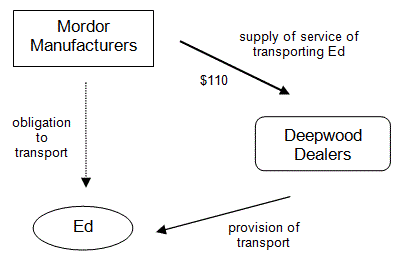
30. Deepwood Dealers makes two supplies: a supply of transporting Ed to and from the dealership and a supply to Mordor Manufacturers of the service of transporting Ed. The supply to Mordor Manufacturers is the reason for the payment by Mordor Manufacturers, and therefore is the only supply for consideration. Deepwood Dealers is liable for $10 of GST (1/11th of $110) for that taxable supply.
Supply by a dealer to a retail customer for consideration (third party consideration)
31. Where the supply of a particular motor vehicle, or particular motor vehicles, to a customer is the reason for the incentive payment and there is nothing specific the dealer does for the manufacturer for the payment, the supply for consideration is the supply of the motor vehicle by the dealer to the customer.
32. Whether the incentive payment is made before, after or at the same time as the supply of the motor vehicle to a customer is not necessarily determinative. An incentive payment is third party consideration for a supply if the reason for making that payment is the supply of that motor vehicle to a particular customer.
33. Whether the customer knows about the payment arrangement between the manufacturer and the dealer or any payment made by the manufacturer is also not determinative of whether an incentive payment can be third party consideration.[4]
Example 4: dealer makes supply for consideration to customer only
34. Cyclops Manufacturers makes certain incentive payments to Storm Dealers under the terms of their dealership agreement. As part of its 'Creating Havok' run-out program, Cyclops Manufacturers pays Storm Dealers $3,300 for each Havok model vehicle when it is sold at a discounted price to a customer.
35. Pat purchases a Havok vehicle from Storm Dealers for $23,100. See following diagram.
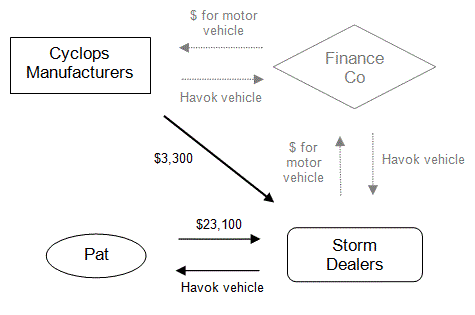
36. The $3,300 payment is made by Cyclops Manufacturers to Storm Dealers under a pre-existing framework in the dealership agreement. However, consistent with the AP Group decision the incentive payment merely encourages the overall business relationship between Cyclops Manufacturers and Storm Dealers. Storm Dealers is not doing anything specific for Cyclops Manufacturers for the payment, other than selling the motor vehicle.
37. Therefore, the $3,300 payment is part of the consideration for the supply of the motor vehicle by Storm Dealers to Pat. It is not consideration for a separate supply by Storm Dealers to Cyclops Manufacturers of supplying the vehicle to Pat.
38. Where the payment is third party consideration for a supply made by a dealer to its customer, the dealer is liable for GST on the total consideration it receives for that supply, including the incentive payment from the manufacturer.[5] However, as the incentive payment is for a taxable supply of a motor vehicle, and that supply is made to the customer and not the manufacturer, the manufacturer has not made a creditable acquisition and is not entitled to an input tax credit.[6]
39. For many types of incentive payments, the manufacturer has a decreasing adjustment under section 134-5. The dealer does not have a corresponding increasing adjustment but is still be liable for GST on the taxable supply of the motor vehicle made to the customer.[7]
40. Where there is third party consideration provided by the manufacturer for the dealer's supply of a motor vehicle to its customer, the customer's entitlement to the input tax credit is less than the GST payable by the dealer on the supply of the motor vehicle. This is because, even if the acquisition is otherwise wholly creditable, the customer provides, or is liable to provide, only part of the consideration for the purchase (with the rest being paid by the manufacturer).[8]
41. Further, where a motor vehicle is a car and the GST inclusive market value of the car exceeds the car limit,[9] section 69-10 reduces the customer's input tax credit to 1/11th of that limit.
Example 5: third party consideration
42. Maximus Manufacturing runs a fleet program under which business fleet customers may purchase motor vehicles from Maximus Manufacturing's dealers at a discounted price.
43. Steve, a business fleet customer, purchases one of Maximus Manufacturing's motor vehicles from Liz's Luxury Dealers. The vehicle's original selling price is $55,000, however, as a fleet customer, Steve pays $44,000. Maximus Manufacturing makes a payment of the $11,000 difference to Liz's Luxury Dealers when Liz's Luxury Dealers sells the motor vehicle to Steve. See following diagram.
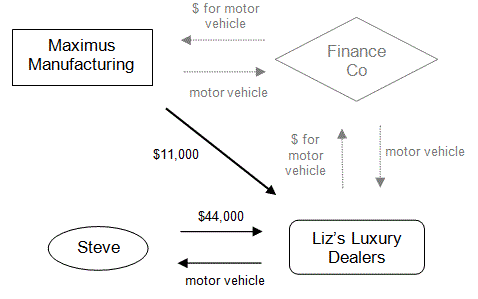
| Purchase price paid by Steve | $44,000 | |
| Incentive payment from Maximus | $11,000 | |
| ---------------- | ---------------- | |
| Total consideration | $55,000 | |
| Including GST of | $5,000 |
44. Liz's Luxury Dealers has made a supply of a particular fleet vehicle to Steve. The supply is the reason for the payment by Maximus Manufacturing. Liz's Luxury Dealers is liable for GST of $5,000, which is the GST payable on the total consideration it received for the supply of the fleet vehicle, being the total of the purchase price paid by Steve and the incentive payment paid by Maximus Manufacturing.
45. Maximus Manufacturing is not entitled to an input tax credit but may have a decreasing adjustment under section 134-5.
46. If Steve is registered for GST and he has made a creditable acquisition, then he may be entitled to an input tax credit for purchasing the motor vehicle but only to the extent of the consideration he provided ($4,000).
No supply for consideration
47. Where the dealer does not make any supply for consideration, the dealer is not liable for GST and the manufacturer is not entitled to an input tax credit. However, in these circumstances, an incentive payment may give rise to other GST consequences - for example, the parties may have adjustments under Division 19[10] or Division 134.[11]
Example 6: no supply for consideration
48. Monster Manufacturing runs a competition for sales assistants employed by one of its dealers, Dexter's Deals, whereby Monster Manufacturing will reward the sales assistant who makes the most sales for the dealership each month with a $100 book voucher. Dexter's Deals involvement in the competition is limited to providing the book voucher to the sales assistant that wins the competition each month. As a result, Dexter's Deals may incur a fringe benefits tax (FBT) liability. Monster Manufacturing will make a payment to Dexter's Deals that is equivalent to the FBT liability incurred by Dexter's Deals.
49. Dexter's Deals has not made a supply to Monster Manufacturing for consideration as there is no conduct which can be identified as a supply - Dexter's Deals does not do anything, or agree to do anything, for that payment.
Division 134 - third party payment adjustments
50. Certain incentive payments made on or after 1 July 2010 may give rise to a decreasing adjustment to manufacturers and an increasing adjustment to dealers (or GST registered customers) under Division 134.[12]
Decreasing adjustments
51. A manufacturer has a decreasing adjustment for an incentive payment it makes to a dealer only if all of the conditions set out in subsection 134-5(1) are satisfied. This requires that:
- (a)
- the manufacturer makes the payment to the dealer that acquires a thing (such as a motor vehicle) that the manufacturer supplied to another entity (for example, a finance company or parts distributor). It does not matter whether the other entity supplies the thing to the dealer,[13]
- (b)
- the manufacturer's supply of the thing to the other entity is a taxable supply or would have been a taxable supply but for a reason to which paragraph 134-5(3)(a) (about GST groups) applies,[14]
- (c)
- the payment is a payment of money, an offset of money the dealer owes the manufacturer or the crediting of an amount of money to an account that the dealer holds,[15]
- (d)
- the payment is made in connection with, in response to or for the inducement of the dealer's acquisition of the thing,[16] and
- (e)
- the payment is not consideration for a supply to the manufacturer.[17]
52. The requirements for a decreasing adjustment can be illustrated in the diagram as follows:
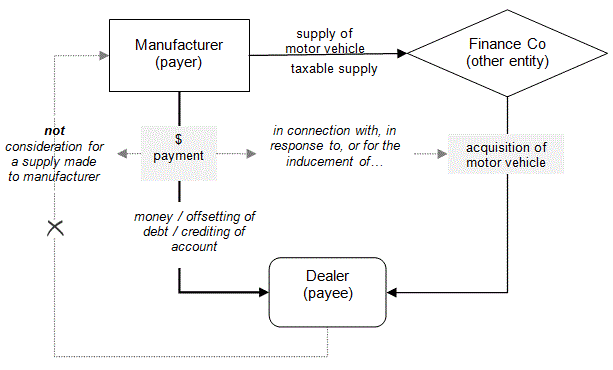
53. Similarly, where the manufacturer makes the payment to the dealer's customer and the requirements of subsection 134-5(1) as outlined in paragraph 51 of this draft Ruling are satisfied, the manufacturer has a decreasing adjustment.
Increasing adjustments
54. A dealer has an increasing adjustment for an incentive payment it receives only if all of the conditions set out in subsection 134-10(1) are satisfied. This requires that:
- (a)
- the dealer receives a payment from the manufacturer that supplied a thing (such as a motor vehicle) that the dealer acquired from another entity (for example, a finance company or parts distributor). It does not matter whether the other entity acquired the thing from the manufacturer,[18]
- (b)
- the dealer's acquisition of the thing from the other entity was a creditable acquisition or would have been creditable but for a reason to which paragraph 134-10(3)(a) (about GST groups) applies,[19]
- (c)
- the payment is a payment of money, an offset of money the dealer owes the manufacturer or the crediting of an amount of money to an account that the dealer holds,[20]
- (d)
- the payment is made in connection with, in response to or for the inducement of the dealer's acquisition of the thing,[21] and
- (e)
- the payment is not consideration for a supply by the dealer.[22]
55. Similarly, where the manufacturer makes the payment to a GST registered customer and the requirements of paragraph 134-10(1) as outlined in paragraph 54 of this draft Ruling are satisfied, the GST registered customer has an increasing adjustment.
Dealer must acquire something that the manufacturer supplied to another entity (paragraphs 134-5(1)(a) and 134-10(1)(a))
56. The incentive payment must be made to a dealer that acquires a thing that the manufacturer supplied to another entity.[23] There may be multiple interposed entities between the manufacturer and dealer.
57. No decreasing or increasing adjustments under Division 134 arise if the dealer acquires the thing:
- •
- directly from a manufacturer, or
- •
- from another entity, but the manufacturer never previously supplied that thing at any stage of the supply chain.
Dealer must actually acquire the thing
58. Whether the incentive payment is made before or after the dealer's acquisition of the thing is not determinative. However, there must be an actual acquisition of the thing by the dealer for there to be an adjustment.
59. An acquisition of the motor vehicle by the dealer under a floor plan arrangement generally occurs on transfer of title from the interposed finance company to the dealer.
60. Some incentive payments, such as those commonly known as delivery or pre-delivery allowances, may be paid by the manufacturer before the dealer acquires the vehicle. In these cases, the adjustment only arises once the dealer acquires the motor vehicle.[24]
61. Merely ordering or obtaining possession of the motor vehicle subsequent to the order would not be sufficient for the purposes of Division 134 where the dealer does not in fact acquire the vehicle. For example, an acquisition may not occur where the dealer swaps the particular vehicle with another dealer.
Example 7: payment for which there is no acquisition of a thing
62. Vadar Manufacturers issues a sales bulletin for April 2014 stating that it will make a payment of $2,000 for each specified model of luxury car ordered by its dealers. One of Vadar Manufacturers' dealers, Ethan's Dealers, orders a luxury car on 21 April 2014. Based on the order submitted in the system, Vadar Manufacturers makes a payment to Ethan's Dealers of $2,000 at the end of May 2014.
63. Before the luxury car is transported to Australia, Ethan's Dealers enters into a swap with Alex's Automobiles in respect of the luxury car it ordered. When the vehicle arrives in Australia, it is delivered to Alex's Automobiles' showroom instead of to Ethan's Dealers' premises. See following diagram.
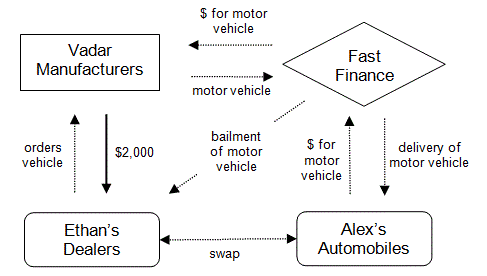
64. Accordingly, paragraph 134-5(1)(a) is not satisfied as Ethan's Dealers never actually acquires the vehicle.
Payment must be made in connection with, in response to or for the inducement of the dealer's acquisition of the thing (paragraphs 134-5(1)(d) and 134-10(1)(d))
65. Determining whether an incentive payment is likely to be made in connection with, in response to, or for the inducement of the dealer's acquisition of a thing will depend on the nature of the particular payment and the relevant circumstances of each case.
66. In the context of Division 134, an incentive payment will be in connection with, in response to or for the inducement of the dealer's acquisition of a thing if that payment relates to the dealer's acquisition of a particular thing. It does not matter if the incentive payment is made before, after or at the same time as the dealer's acquisition of the thing.
67. For the purposes of discussing paragraphs 134-5(1)(d) and 134-10(1)(d), references to the term 'in connection with' should also be read as references to the terms 'in response to' or 'for the inducement of' (where appropriate).
Acquisition of a particular thing or particular things
68. The reference to 'the thing' in paragraphs 134-5(1)(d) and 134-10(1)(d) indicates that there must be a connection between the incentive payment and the acquisition of a particular thing or particular things by the payee, rather than the acquisition of things generally.
69. For example, an incentive payment made by a manufacturer to a dealer where the dealer acquires a specified number of vehicles in a particular month as set by the manufacturer (commonly known as a 'wholesale target' incentive payment). The relevant acquisition is the acquisition of those particular vehicles.
70. On the other hand, an incentive payment made by a manufacturer to a dealer where the payment has nothing to do with the dealer's acquisition of motor vehicles or anything else will not be in connection with the acquisition of a particular thing or particular things.
Payment must relate to the dealer's acquisition of a particular thing
71. An incentive payment will relate to the dealer's acquisition of a particular thing if it has the effect of indirectly reducing the amount paid by the dealer for the thing.
72. An incentive payment made by a manufacturer to a dealer in connection with something acquired under a bailment arrangement will not, in form, reduce the acquisition price for the vehicle as the dealer does not acquire the thing directly from the manufacturer. However, the incentive payment may, in substance, reduce the dealer's actual costs of acquiring the vehicle.
73. Determining whether an incentive payment has the substantive effect of indirectly reducing the price of the thing acquired is dependent on the nature of the particular payment and the relevant circumstances of each case.
Example 8: payment made for dealer's acquisition of specified number of vehicles
74. For the period 1 January to 30 June 2014, Lionel Manufacturing agrees to pay its authorised dealer an amount equivalent to 2% of the wholesale price of each motor vehicle that the dealer acquires in a given month where the dealer acquires 10 vehicles for each model that Lionel Manufacturing specifies. Ashlea's Dealership, an authorised dealership, acquires 10 vehicles of an eligible model. Lionel Manufacturing pays Ashlea's Dealership $8,800, being 2% of the wholesale price of each vehicle. See following diagram.
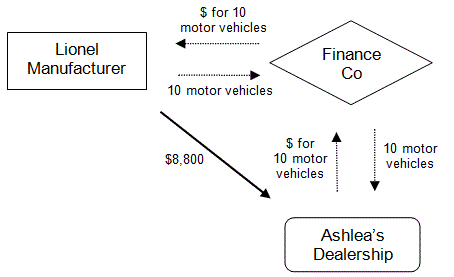
75. The payment from Lionel Manufacturing to Ashlea's Dealership is in connection with the acquisition of the particular motor vehicles by Ashlea's Dealership in the particular month, as the payment has the substantive effect of indirectly reducing Ashlea's Dealership's costs of acquiring those vehicles.
Example 9: general support payment
76. Gondor Dealers decides to build a new showroom and renovate its servicing area. Merry's Manufacturing makes a payment to Gondor Dealers to contribute to the cost of building the new showroom and the renovation of the servicing area. When making the payment, Merry's Manufacturing makes it clear that Gondor Dealers is not under any obligation to build the showroom and the payment does not need to be returned if the showroom does not proceed.
77. The payment is made to support Gondor Dealers' general business operations with no obligation on Gondor Dealers to actually build the showroom. The payment is not connected to Gondor Dealers' acquisition of any particular thing that Merry's Manufacturing previously supplied, and the payment does not have the effect of indirectly reducing the price of any particular thing acquired by Gondor Dealers. Accordingly, no adjustments arise under Division 134.
Payment must not be consideration for a supply (paragraphs 134-5(1)(e) and 134-10(1)(e))
78. For a decreasing adjustment to arise, the payment must not be consideration for a supply made to the manufacturer.[25]
79. For an increasing adjustment to arise, the payment must not be consideration for a supply from the dealer, whether that supply is made to the manufacturer or any other entity (such as a retail customer).[26]
Example 10: incentive payment is consideration for a supply to the manufacturer
80. Golden Manufacturers pays Matt's Motors to organise direct marketing to support Golden Manufacturers' end of year sale promotions. Matt's Motors makes a supply to Golden Manufacturers for consideration in the form of the incentive payment.
81. As the reason for the payment is the supply of organising direct marketing by Matt's Motors to Golden Manufacturers, Golden Manufacturers has made a creditable acquisition, and therefore does not have a decreasing adjustment 134-5. Similarly, Matt's Motors has made a supply for consideration and does not have an increasing adjustment under section 134-10.
Example 11: incentive payment is consideration for a supply to a third party
82. Yogi Manufacturing makes a payment to Boo Boo Dealers for each fleet vehicle sold to a fleet customer. The payment is equivalent to the discount received by the fleet customer, in accordance with the terms and conditions of the fleet program offered by Yogi Manufacturing. Prasanna, a fleet customer, purchases a vehicle from Boo Boo Dealers for $44,000. Yogi Manufacturing pays Boo Boo Dealers an incentive payment of $2,200. See following diagram.
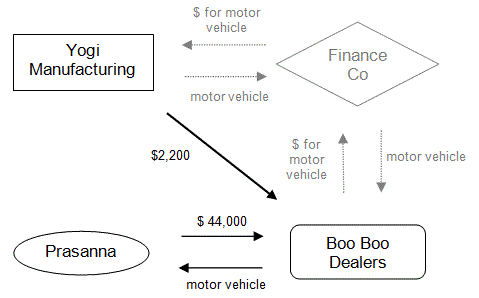
83. Yogi Manufacturing's payment is consideration for Boo Boo Dealers' supply of a fleet vehicle to Prasanna, even though it is Yogi Manufacturing that provides that consideration.
84. No supply has been made to Yogi Manufacturing and therefore, paragraph 134-5(1)(e) is satisfied. Assuming all other requirements in section 134-5 are satisfied, Yogi Manufacturing has a decreasing adjustment of $200.
85. However, as the payment is consideration for a supply made by Boo Boo Dealers, paragraph 134-10(1)(e) is not satisfied and Boo Boo Dealers has no increasing adjustments under section 134-10. Instead, Boo Boo Motors is liable for GST of $4,200, being the GST on the total consideration it receives for the supply of the vehicle to Prasanna.
| Purchase price paid by Prasanna | $44,000 | |
| Incentive payment from Yogi | $2,200 | |
| ---------------- | ---------------- | |
| Total consideration | $46,200 | |
| Including GST of | $4,200 |
Worked Examples
86. Paragraphs 99 to 216 contain a number of worked examples illustrating the views outlined in this draft Ruling. When the final Ruling is issued, these examples will form part of the legally binding section of the Ruling.
Third party adjustment notes
87. A decreasing adjustment under section 134-5 is not attributable to a tax period until the manufacturer holds a third party adjustment note.[27]
88. The manufacturer must give a copy of a third party adjustment note to the dealer within 28 days of:
- •
- the dealer (or GST registered customer) requesting the payer for a copy, or
- •
- the manufacturer becoming aware of the adjustment before the copy is requested.[28]
Approved form
89. A document issued by a manufacturer is in the approved form for a third party adjustment note if it includes the information required by subsection 134-20(1), including the additional information requirements which the Commissioner has determined in the legislative instrument,[29] and if applicable section 54-50 (which is about GST branches).[30]
90. Details of more than one adjustment may be shown on a third party adjustment note. If a document includes multiple adjustments and does not meet the requirements of subsection 134-20(1) for a particular adjustment or adjustments, it remains an adjustment note in the approved form for all other adjustments for which the requirements of subsection 134-20(1) are met.
91. A document in electronic form that meets the requirements of subsections 134-20(1) and 54-50(1) (if applicable) will be in the approved form for an adjustment note.[31]
Information requirements in the legislative instrument
92. The legislative instrument outlines that for a document to be a third party adjustment note, it must contain certain information, or enough information to enable that information to be clearly ascertained, including the following:
- •
- the manufacturer's identity, as specified in a form other than the manufacturer's ABN[32]
- •
- the dealer's identity or ABN
- •
- a description of the thing that the dealer acquires (including the quantity) and to which the payment relates
- •
- the amount of the third party payment
- •
- the amount of the manufacturer's decreasing adjustment under subsection 134-5(2), and
- •
- the date the note is issued.
Clearly ascertained
93. Clause 5 of the legislative instrument requires that the particular information listed can be clearly ascertained from the information in the document. This means that the information does not have to be specifically stated or in a particular format. What is required is that the information can be found in the document, or determined from information within the document. It further means that to be clearly ascertained, enough information must be present and it must be clear what the information represents.
94. If the information required by clause 5 can only be determined by reference to another external source (such as the Australian Business Register) or another document, then that information cannot be clearly ascertained from the information contained in that document as required by the opening words of clause 5.[33]
Circumstances in which the Commissioner may exercise the discretion to treat a document as a third party adjustment note
95. The Commissioner has the discretion to treat a particular document, which is not a third party adjustment note, as a third party adjustment note.[34] The Commissioner will exercise this discretion on a case-by-case basis.
96. The factors outlined in Law Administration Practice Statement PSLA 2004/11 The Commissioner's discretions to treat a particular document as a tax invoice or adjustment note (in relation to tax invoices under section 29-70 and adjustment notes under section 29-75) may be relevant when considering the exercise of the discretion to treat a document as a third party adjustment note. These factors are not exhaustive and there may be other circumstances that are relevant in a particular case.
97. When the Commissioner exercises the discretion to treat a document as a third party adjustment note, that document is a third party adjustment note as defined in section 195-1. This treatment applies for the purposes of both the manufacturer and the dealer. The document for which the discretion has been exercised is treated as a third party adjustment note for the adjustment from the date it was created.
98. However, this does not mean that the manufacturer had, before the exercise of the discretion, complied with their obligation to issue a third party adjustment note within the required time.
Worked examples
99. The following examples, although not exhaustive of all scenarios, demonstrate the application of the propositions in this draft Ruling to common payments made in the motor vehicle industry.
100. The GST consequences of any incentive payment are highly dependent on the individual facts and circumstances of each arrangement. Any material variation to the facts in the following examples may give rise to a different GST outcome. Therefore, care should be taken in drawing conclusions where the material facts and circumstances differ from those discussed in the examples below, even if the payments are referred to using similar names or descriptions.
Fleet rebates
101. Fleet rebates are often paid where the dealer sells a particular class of vehicle (ordered as 'non-fleet' vehicles or at 'non-fleet' pricing) to a particular class of customers known as fleet customers. These are generally business or government customers.
102. Fleet rebates may be paid to the dealer, or directly to the customer. Where they are paid to the dealer, the dealer is generally required to reflect the rebate as a discount in the cost given to the customer.
Worked Example 1: fleet rebate paid to dealer for vehicle acquired as non-fleet vehicle
103. Kevin Car Distributors runs a fleet program for business customers. Under the program, businesses may purchase motor vehicles of particular models at or below a fleet price (as listed in a monthly schedule), from any of Kevin Car Distributors authorised dealers. Robert's Dealership is an authorised dealership.
104. Kevin Car Distributors makes a fleet rebate payment to Robert's Dealership when Robert's Dealership sells motor vehicles to fleet customers at a price specified by Kevin Car Distributors.
105. The fleet rebate is payable in respect of each motor vehicle sold to a fleet customer that is already held in stock by Robert's Dealership. There are different categories of fleet customers which determine the maximum amount that Robert's Dealership may charge for the vehicle.
106. Robert's Dealership orders a vehicle from Kevin Car Distributors via Fast Finance Co for $33,000. Robert's Dealership then sells that vehicle to a fleet customer, Bruce, for $55,000. Kevin Car Distributors pays Robert's Dealership the fleet rebate of $4,400. See following diagram.
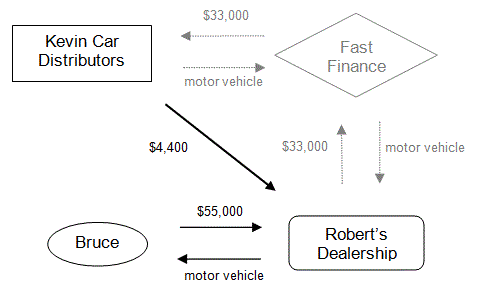
Is there a supply for consideration?
107. The sale of the vehicle by Robert's Dealership to Bruce is the reason for the payment by Kevin Car Distributors to Robert's Dealership. The price paid by Bruce and the payment from Kevin Car Distributors together form the consideration for the supply of the motor vehicle, which is $59,400.
| Purchase price paid by Bruce | $55,000 | |
| Incentive payment from Kevin | $4,400 | |
| ---------------- | ---------------- | |
| Total consideration | $59,400 | |
| Including GST of | $5,400 |
108. No other supplies made by Robert's Dealership are identifiable in this example.
109. Robert's Dealership is therefore liable for GST of $5,400, being the GST payable on the full consideration that it received for the supply of the motor vehicle.
110. As Kevin Car Distributor has not made a creditable acquisition, it is not entitled to an input tax credit.
111. If Bruce is registered for GST and makes a creditable acquisition of the vehicle, he will be entitled to an input tax credit of $5,000, being the input tax credit entitlement referable to the extent of consideration provided by him.
Are there any adjustments under Division 134?
112. Robert's Dealership has acquired a motor vehicle that was supplied by Kevin Car Distributors to the interposed finance company as a taxable supply.
113. The payment is in connection with the acquisition of the vehicle by Robert's Dealership as Robert's Dealership would have acquired the vehicle at a non-fleet price with the knowledge that the payment would be made if the vehicle was subsequently sold to a fleet customer at fleet pricing.
114. Having regard to the nature of the payment, even though the reason for the payment is the supply of the vehicle by Robert's Dealership to Bruce, the payment is in connection with Robert's Dealership's acquisition of the vehicle from the interposed finance company.
115. This is because Kevin Car Distributor's payment is payable in respect of each motor vehicle sold to a fleet customer that was already held by Robert's Dealership. The payment has the effect of indirectly reducing the price of the vehicle acquired by Robert's Dealership sold to fleet customers so that what Robert's Dealership pays for the vehicle is effectively what it would have paid had it acquired the vehicle at the fleet price. Therefore, Kevin Car Distributors has a decreasing adjustment under section 134-5 of $400.
116. As Robert's Dealership has made a supply for consideration, being the supply of the motor vehicle to Bruce, and is liable for GST on that taxable supply, it does not have an increasing adjustment under section 134-10 because paragraph 134-10(1)(e) is not satisfied.
Worked Example 2: fleet rebate paid to a dealer before sale to customer
117. Skyrise Manufacturing runs a fleet program for business customers. Under the program, business customers may purchase motor vehicles of particular 'qualifying' models at or below a fleet price from any of Skyrise Manufacturing's authorised dealers. Skyrise Manufacturing pays its dealers a fleet rebate once those qualifying models are delivered to the dealers' showrooms. However, if the qualifying vehicle is sold to a non-fleet customer, the dealer is required to repay the fleet rebate.
118. Daikoku Dealers, an authorised dealership, orders five qualifying vehicles and Skyrise Manufacturing separately pays Daikoku Dealers $3,300 for each vehicle. At this point in time, Daikoku Dealers has not yet found a customer for the vehicles.
119. Kasey is a fleet customer and purchases one of the qualifying vehicles from Daikoku Dealers for $23,100. See following diagram.
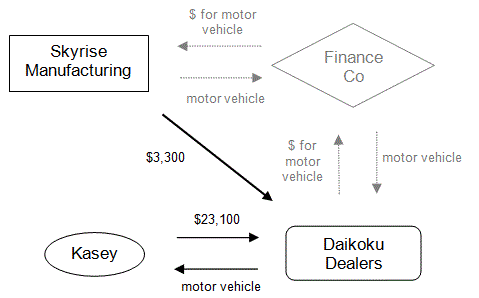
Is there a supply for consideration?
120. The sale of the vehicle by Daikoku Dealers to Kasey is the reason for the payment. This is because Skyrise Manufacturing made the payment for the future supply of the vehicle to a fleet customer. The price paid by Kasey and the payment from Skyrise Manufacturing together form the consideration for the supply of the motor vehicle, which is $26,400.
| Purchase price paid by Kasey | $23,100 | |
| Incentive payment from Skyrise | $3,300 | |
| ---------------- | ---------------- | |
| Total consideration | $26,400 | |
| Including GST of | $2,400 |
121. Daikoku Dealers is therefore liable for GST of $2,400, being the GST payable on the full consideration that it received for the supply of the motor vehicle. It does not matter that Skyrise Manufacturing pays Daikoku Dealers before it makes the supply to Kasey. Consideration may be provided for a supply at any time.
Are there any adjustments under Division 134?
122. Daikoku Dealers has acquired a motor vehicle that was supplied by Skyrise Manufacturing to the interposed finance company as a taxable supply.
123. While the reason for the payment is the supply of the vehicle by Daikoku Dealers to Kasey, the payment is in connection with the acquisition of the vehicle from the interposed finance company by Daikoku Dealers because the payment has the effect of indirectly reducing the price of the vehicle acquired by Daikoku Dealers and sold to Kasey by $3,300. Therefore, Skyrise Manufacturing has a decreasing adjustment under section 134-5 of $300.
124. As Daikoku Dealers has made a supply for consideration, being the supply of the motor vehicle to Kasey and is liable for GST on that taxable supply, it does not have an increasing adjustment under section 134-10 because paragraph 134-10(1)(e) is not satisfied.
Worked Example 3: fleet rebate paid to customer
125. Easy Driving Distributors offers a rebate to fleet customers who buy its vehicles from its dealers. The customers are given an option to either receive the rebate directly from Easy Driving Distributors as a cheque or to redirect the rebate to its dealer to reduce the purchase price of the vehicle.
126. Tony is a fleet customer who is registered for GST and acquires a vehicle from Galactic Dealers for $22,000. As a fleet customer, Tony is entitled to receive a rebate of $2,200 from Easy Driving Distributors. Galactic Dealers ordered the vehicle for $11,000. See following diagram.
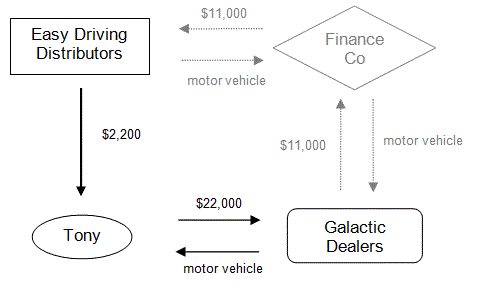
Is there a supply for consideration?
127. Unless Tony's enterprise involves making supplies of motor vehicles, the only supply for consideration is the supply of the motor vehicle by Galactic Dealers to Tony. The consideration provided for that supply is Tony's payment of $22,000. Galactic Dealers is therefore liable for GST of $2,000. Tony has an input tax credit of $2,000 for his acquisition of the motor vehicle.
Are there any adjustments under Division 134?
128. The fleet payment is made in respect of a vehicle that Tony acquires from Galactic Dealers as it has the effect of indirectly reducing the price of the vehicle acquired by Tony. Easy Driving Distributors has a decreasing adjustment of $200 under section 134-5 and Tony has an increasing adjustment of $200 under section 134-10.
Run-out model incentive payments
129. These payments are made where dealers sell specified model vehicles at or below a specified price to encourage dealers to reduce their floor stock.
Worked Example 4: run out model incentive payment
130. In January 2014, Sikaram Manufacturers issues a sales bulletin to its dealers informing them of a new incentive program to encourage dealers to reduce their floor stock of specified 2013 models in preparation for the introduction of the 2014 range.
131. As part of the program, Sikaram Manufacturers will pay its dealers $2,200 for each CPR XIII model that is sold and delivered to a customer in January. There is no requirement that the payment be passed onto the customer.
132. Catherine purchases a CPR XIII from Carter Dealers for $33,000. Carter Dealers makes full payment to its finance company and title is transferred to Carter Dealers then to Catherine. Sikaram Distributors pays Carter Dealers $2,200. See following diagram.
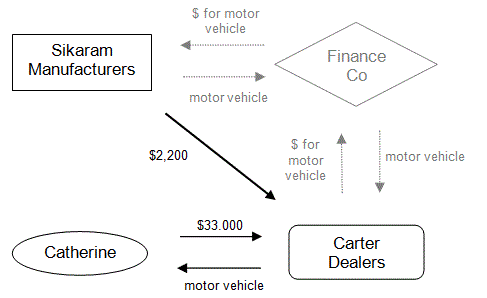
Is there a supply for consideration?
133. Carter Dealers makes a supply of the vehicle to Catherine for consideration comprising the $33,000 paid by Catherine and the $2,200 incentive payment from Sikaram Manufacturers (which is third party consideration for the supply of the vehicle to Catherine). Carter Dealers is liable for GST of $3,200.
| Purchase price paid by Catherine | $33,000 | |
| Incentive payment from Sikaram | $2,200 | |
| ---------------- | ---------------- | |
| Total consideration | $35,200 | |
| Including GST of | $3,200 |
134. As Sikaram Manufacturers has not made a creditable acquisition, it is not entitled to any input tax credits.
Are there any adjustments under Division 134?
135. Sikaram Manufacturers has made a payment to Carter Dealers, which acquired the vehicle that Sikaram Manufacturers supplied to the interposed finance company as a taxable supply. Further, the payment is made for the inducement of Carter Dealers' acquisition of the vehicle as the payment relates to Carter Dealers acquisition of the vehicle because the $2,200 has the effect of indirectly reducing the price Carter Dealers paid for the vehicle by $2,200. Sikaram Manufacturers therefore has a decreasing adjustment of $200 under section 134-5.
136. Carter Dealers does not have an increasing adjustment as it made a supply of the motor vehicle to Catherine for consideration and paragraph 134-10(1)(e) is not satisfied.
Worked Example 5: incentive payment for the sale of ex-demonstrators
137. As part of its dealership agreements, Veloce Importers requires its dealers to hold a pool of demonstrator vehicles each year. The pool must contain one vehicle from each current range model. In recognition of the fact that when an ex-demonstrator vehicle is ultimately sold to a customer, it will be sold as a 'used' vehicle, Veloce Importers pays its dealers a 'demonstrator support payment' for each ex-demonstrator sold to a customer provided the dealer maintained the required pool for the year.
138. Daniel's Deals is one of Veloce Importers' dealers and sells an ex-demonstrator from its 2013 pool to Christina for $11,000. Veloce Importers pays Daniel's Deals a demonstrator support payment of $3,300. See following diagram.
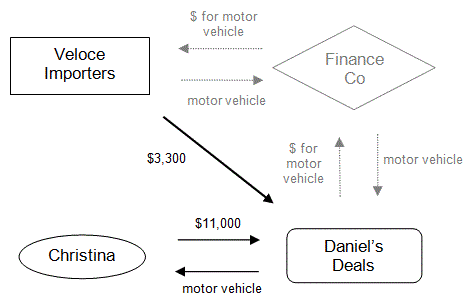
Is there a supply for consideration?
139. The reason for Veloce Importers' payment is Daniel's Deals' supply of the particular ex-demonstrator vehicle to Christina and the payment is third party consideration for that supply. Daniel's Deals is therefore liable for GST of $1,300.
| Purchase price paid by Christina | $11,000 | |
| Incentive payment from Veloce | $3,300 | |
| ---------------- | ---------------- | |
| Total consideration | $14,300 | |
| Including GST of | $1,300 |
140. Veloce Importers is not entitled to an input tax credit as it has not made a creditable acquisition.
Are there any adjustments under Division 134?
141. Veloce Importers has a decreasing adjustment of $300 for the payment as the payment is made in connection with Daniel's Deals' acquisition of the vehicle - the payment relates to Daniel's Deals' acquisition and the $3,300 indirectly reduces the acquisition price of the vehicle for Daniel's Deals.
142. Daniel's Deals does not have an increasing adjustment as the payment is consideration for the supply Daniel's Deals made to Christina and paragraph 134-10(1)(e) is not satisfied.
Driveaway support payments
143. Dealers sometimes sell vehicles at a 'driveaway' price, which means that the costs of registration, stamp duty and third party insurance have already been paid for.
144. In recognition that these costs tend to vary depending on the location of the dealership, manufacturers may make payments to its dealers to ensure that the same model vehicle can be sold at the same 'driveaway' price irrespective of where the dealership is located. The amount of the payment will vary from dealer to dealer depending on the relevant costs they incur.
Worked Example 6: driveaway prices
145. Under a 'drive away support program', Dynasty Manufacturers pays each of its dealers an amount to equalise the on-road costs (for example, stamp duty, registration and compulsory third party insurance) across all of its dealerships nationwide. The payment allows each dealer to sell a particular model vehicle at the same price irrespective of the dealership's location. The dealer pays for the registration and insurance, and sells a registered and insured vehicle at the specified price to the customer.
146. Dynasty Manufacturers has two dealerships - Evelyn Motors in Victoria and Kimberley Dealers in Queensland. Dynasty Manufacturers advertises a new range vehicle at $55,000 drive away.
147. The on-road costs for this model vehicle is $4,320 in Victoria, and $4,100 in Queensland. In order to ensure that both Evelyn Motors and Kimberley Dealers are able to retail the vehicle at the same driveaway price of $55,000, Dynasty Manufacturers pays Evelyn Motors $220 to compensate for the $220 difference in on-road costs.
148. Mark purchases a vehicle from Evelyn Motors for $55,000.
| Evelyn Motors | Kimberley Dealers | ||
| On-road costs | $4,320 | $4,100 | |
| plus | Other costs + margin | $50,900 | $50,900 |
| ---------------- | ---------------- | ||
| Total costs | $55,220 | $55,000 | |
| less | Incentive from Dynasty | $220 | - |
| ---------------- | ---------------- | ||
| Driveaway price | $55,000 | $55,000 | |
| ---------------- | ---------------- |
Is there a supply for consideration?
149. Evelyn Motors makes a supply of a registered and insured vehicle to a customer, Mark.
150. The supply to Mark is not the reason for the $220 payment - the reason for the payment is to equalise Evelyn Motors and Kimberley Dealers' costs of acquiring the vehicle. Therefore, the $220 payment is not third party consideration for the supply to Mark.
151. Further, Evelyn Motors has not made a supply for consideration to Dynasty Manufacturers as Evelyn Motors has not done anything for that payment.
Are there any adjustments under Division 134?
152. While the payment is not for any supply by Evelyn Motors, the payment is in relation to Evelyn Motors' acquisition of the motor vehicle from its finance company and the eventual sale to Mark. The payment relates to registering and insuring the acquired vehicle and has the effect of reducing Evelyn Motors' costs associated with the motor vehicle (in effect, to bring it in line with the costs incurred by Kimberley Dealers). As such, Dynasty Manufacturers has a decreasing adjustment of $20 under section 134-5 and Evelyn Motors has an increasing adjustment of $20 under section 134-10.
Volume targets
153. Manufacturers often make payments to dealers for achieving certain targets. The targets may be calculated on a per vehicle basis, or as a lump sum for the total amount sold or acquired.
Worked Example 7: retail target incentive payment
154. Invictus Importers, a motor vehicle importer, runs a retail target incentive program for its dealers.
155. In June, Invictus Importers informs its dealers that if dealers achieve their sales target for the month, Invictus will pay them an incentive payment of $150 for each vehicle sold.
156. In July, Invictus Importers modifies the program such that if dealers achieve (or exceed) their sales target for the month, Invictus Importers will pay them a flat dollar amount of $12,000.
157. Will & Sean Dealers, one of Invictus Importers' authorised dealerships, achieves its retail target for both June and July and receives both incentive payments.
Is there a supply for consideration?
158. In all cases, there is no supply for consideration as Will & Sean Dealers is not doing anything specific for Invictus Importers in selling the vehicle - selling cars is merely part of Will & Sean Dealers' general business operations. The reason for the payment is Will & Sean Dealers selling the total number of vehicles in that month, and not the supply of any particular vehicle. Accordingly, Will & Sean Dealers does not have a GST liability in relation to the payment.
Are there any adjustments under Division 134?
159. While Will & Sean Dealers is not doing anything specific for the payments, the payments are made in connection with the dealers' acquisitions of the vehicles. This is because, under a floor plan arrangement, the supply of a motor vehicle by Will & Sean Dealers to a customer occurs immediately after Will & Sean Dealers' acquisition of the motor vehicle from the finance company, and no acquisition would take place if the vehicle is not sold. As such, when Will & Sean Dealers sells the target number of vehicles, it has also acquired that target number of vehicles.
160. Therefore, the payment has the effect of indirectly reducing Will & Sean Dealers' acquisition costs in respect of the target number of vehicles acquired and subsequently sold. Therefore, Invictus Importers has a decreasing adjustment under section 134-5, and Will & Sean Dealers has an increasing adjustment under section 134-10.
Worked Example 8: wholesale target incentive payment
161. North Pole Distributors runs a wholesale target incentive program in which it will make a payment to a dealer where the dealer orders vehicles in excess of a specified monthly target set by North Pole Distributors.
162. The targets are set based on the size and past performance of the particular dealer. There is a maximum ordering entitlement that the manufacturer sets for each dealer for any given month. A dealer cannot order more than their maximum ordering entitlement.
163. For the month of November, North Pole Distributors sets a target of 100 vehicles and the payment is determined based on 1.5% of the dealer invoice price for each vehicle that the dealer orders from North Pole Distributors.
164. Icecap Dealers orders 105 vehicles in November. In December, North Pole makes a payment to Icecap Dealers for achieving the November target. Icecap Dealers subsequently sells all 105 vehicles to its customers.
165. In December, North Pole Distributors sets another target of 100 vehicles, but this time the payment is calculated as a flat payment of $11,000. Icecap Dealers orders 110 vehicles and subsequently sells all those vehicles to its customers.
Is there a supply for consideration?
166. In all cases, there is no supply for consideration as Icecap Dealers is not doing anything specific for North Pole Distributors in acquiring the vehicles. Acquiring cars it is merely part of Icecap's general business operations. The reason for the incentive payments is Icecap Dealers acquiring the target number of vehicles in each month, and not the supply of any particular vehicle. Accordingly, Icecap Dealers does not have a GST liability in relation to any of the payments.
Are there any adjustments under Division 134?
167. Both payments are connected to, and payable in respect of Icecap Dealers' acquisition of the particular vehicles during those months. How the amount of the payment is determined is not relevant - instead, it is the fact that the payment has the effect of indirectly reducing Icecap Dealers' costs of acquiring the vehicles that means the payment is connected to the acquisition of the vehicles.
168. North Pole Distributors has a decreasing adjustment under section 134-5 for each payment it makes, and Icecap Dealers has an increasing adjustment under section 134-10 for each payment it receives.
Performance targets not related to motor vehicles
169. Payments may be made where the dealer achieves certain performance targets that are not related to the supply or acquisition of vehicles. The payments may be made in relation to the dealer meeting certain customer service standards, holding a particular market share or conforming to particular showroom requirements.
Worked Example 9: payment for meeting standards
170. Stadium Distributors, makes payments to its dealers under a 'Drive to the Sky' program, which is designed to encourage dealers to run their dealerships more efficiently and to be more profitable.
171. Under the program, each dealer is assessed and scored for satisfactorily meeting standards prescribed by Stadium Distributors. These standards include complying with showroom presentation requirements, levels of customer service, holding a certain market share and achieving certain sales targets.
172. Stadium Distributors pays an annual bonus to qualifying dealers that is calculated on a percentage of the dealer's monetary turnover which is referable to the score received.
173. Elite Dealers is a participating dealer in Stadium Distributor's 'Drive to the Sky' program. Elite Dealers is given a score of 75 out of 100. Under the rules of the program, the score of 75 points entitles Elite Dealers to a payment of 7.5% of Elite Dealers' turnover for 2012, which is $2,500,000. Stadium Distributors pays Elite Dealers a bonus calculated as 7.5% of $2,500,000.
Is there a supply for consideration?
174. As Elite Dealers has not done, or agreed to do, anything specific for Stadium Distributors, Elite Dealers has not made a supply for consideration. The criteria on which the dealer is scored are for the purposes of calculating the payments and are largely about meeting general standards.
175. Further, there is no specific obligation on the dealers to meet these standards. The payments are simply the encouragement of the overall business relationship between Stadium Distributors and Elite Dealers to the mutual benefit of both.
Are there any adjustments under Division 134?
176. Stadium Distributors does not have a decreasing adjustment under section 134-5 and Elite Dealers does not have an increasing adjustment under section 134-10 because the payment is not made in connection with Elite Dealers' acquisition of anything.
Incentive payments made to reimburse dealer for the cost of incurring financing and bailment charges
177. Under a floor plan arrangement, the finance company generally imposes a finance or bailment charge on dealers. The charge starts accruing from the date the finance company purchases the vehicle (generally once the vehicle is dispatched from the manufacturer's assembly plant) until the vehicle is in a saleable condition.
178. Manufacturers may pay allowances to dealers to compensate for these finance charges accrued while:
- •
- the vehicle is in transit to the dealer and the dealer does not have physical possession of the vehicle (in some cases, this is known as a 'delivery allowance')
- •
- the dealer has physical possession of the vehicle but the vehicle is not yet in saleable condition (in some cases, this is known as a 'pre-delivery allowance'), or
- •
- the dealer's customer has possession of the vehicle but there are delays in settlement such that the customer has not paid in full for the vehicle and title has not yet passed.
179. The allowances may be calculated based on the current Bank Bill Rate plus a margin specified by the manufacturer, and are payable for a set period of time depending on the type of allowance.
Worked Example 10: delivery allowance
180. Seagull Manufacturers makes a payment to Beach Motors to compensate for bailment charges imposed on Beach Motors by the interposed finance company, El Gordo Financing Co, for vehicles that Beach Motors dealership orders while the vehicles are in transit from the assembly plant to Beach Motors. The payment is calculated based on the period nominated in days required for vehicle shipment to the nominated delivery destination at the prevailing Bank Bill rate plus a margin of 1.5%. If the motor vehicle is not acquired, Beach Motors is required to repay the allowance to Seagull Manufacturers.
181. Beach Motors orders a vehicle from Seagull Manufacturing under the floor plan arrangement. Four days later, the vehicle is delivered to Beach Motors' showroom. The finance charge incurred by Beach Motors during this period is $330. Seagull Manufacturing makes a payment of $330 to Beach Motors. Beach Motors eventually sells the vehicle to Erin, a retail customer. See following diagram.
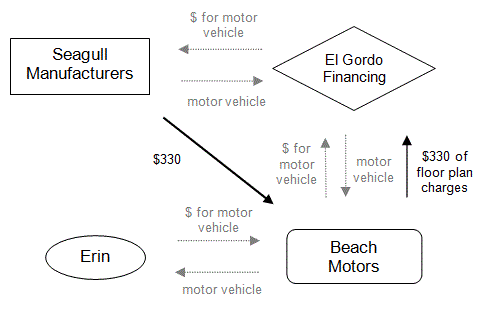
Is there a supply for consideration?
182. Consistent with the Tribunal's decision in AP Group Limited v. Commissioner of Taxation [2012] AATA 409, Beach Motors does not make a supply for consideration to Seagull Manufacturers.
183. The payment is also not third party consideration for the supply of the motor vehicle to Erin because the supply to Erin is not the reason for the payment.
Are there any adjustments under Division 134?
184. Under the bailment, El Gordo Financing makes two separate supplies to Beach Motors for which two separate payments are made:[35]
- •
- the supply of the right to display or use the vehicle prior to Beach Motors paying the purchase price in full and the transfer of title from El Gordo Financing Co to Beach Motors, for which the bailment charges are payable, and
- •
- the supply of the motor vehicle itself to Beach Motors for which the purchase price of the vehicle is payable.
185. While the delivery allowance is not for the supply of the motor vehicle by El Gordo Financing Co to Beach Motors, the payment is in relation to Beach Motors' acquisition of the motor vehicle from El Gordo Financing Co.
186. This is because the delivery allowance is paid to compensate Beach Motors for the bailment charges incurred while the vehicle is in transit. That is a cost incurred by Beach Motors in relation to its acquisition of the motor vehicle from El Gordo Financing Co under the floor plan arrangement. The payment has the effect of indirectly reducing Beach Motors' acquisition costs.
187. Therefore, Seagull Manufacturing has a decreasing adjustment under section 134-5 and Beach Motors has an increasing adjustment under section 134-10.
Worked Example 11: pre-delivery allowance
188. Seagull Manufacturers makes a payment to Beach Motors to compensate for bailment charges imposed to Beach Motors by the interposed finance company, El Gordo Financing Co, for the period required to prepare new vehicles for sale. The vehicles are already in Beach Motors' possession but are not yet ready for sale. The pre-delivery period involves Beach Motors undertaking inspection, mechanical checks, cleaning and other services as specified by Seagull Manufacturers. The payment covers four days' worth of interest calculated at the prevailing Bank Bill rate plus a margin of 1.5%. If the motor vehicle is not acquired, Beach Motors is required to repay the allowance to Seagull Manufacturers.
189. Beach Motors orders a vehicle from Seagull Manufacturing under the floor plan arrangement. The vehicle is delivered to Beach Motors' showroom but is not ready for display. Beach Motors undertakes the required mechanical checks and cleans the vehicle before displaying the vehicle in its showroom. Beach Motors eventually sells the vehicle to Paul, a retail customer.
190. Seagull Manufacturing makes a payment of $440 to Beach Motors to cover the four days of interest expense incurred. See following diagram.
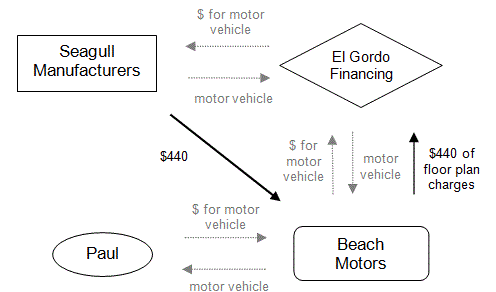
Is there a supply for consideration?
191. Similar to Worked Example 10, Beach Motors does not make a supply for consideration to Seagull Manufacturers.
Are there any adjustments under Division 134?
192. The pre-delivery allowance is paid to compensate Beach Motors for the bailment charges incurred while the vehicle is in Beach Motors' possession but is not yet ready for sale. However, for the same reasons in Worked Example 10, Seagull Manufacturing has a deceasing adjustment under section 134-5 and Beach Motors has an increasing adjustment under section 134-10.
Worked Example 12: settlement delay allowance
193. Omega Importers and Theta Finance are members of the same GST group. Delta Dealers (which is not a member of the same group) acquires a motor vehicle from Omega Importers, through Theta Finance, under a floor plan arrangement.
194. Omega Importers makes a payment to Delta Dealers to compensate it for finance charges imposed by Theta Finance when there is a delay in the settlement of a sale of a vehicle by Delta Dealers to a Government fleet customer. The payment is calculated based on the number of days between the day the vehicle is delivered to a customer and the customer making full payment for the vehicle at the prevailing Bank Bill rate plus a margin of 1.5%. If the motor vehicle is not acquired, Delta Dealers is required to repay the allowance to Omega Importers.
195. Delta Dealers orders a vehicle from Omega Importers under the floor plan arrangement. GDep, a Government fleet customer, enters into a contract of sale with Delta Dealers to purchase the vehicle. Under the terms of that agreement, GDep is given possession of the vehicle, with a deferred payment date.
196. As Delta Dealers has not yet received full payment from GDep for the vehicle, it does not pay Theta Finance for the vehicle, and continues to incur floor plan charges. When GDep makes full payment a month later, Delta Dealers pays Theta Finance for the vehicle in full and title is transferred to Delta Dealers and then to GDep.
197. Omega Importers pays Delta Dealers $2,310 for the floor plan charges it incurred in relation to that vehicle that month. See following diagram.
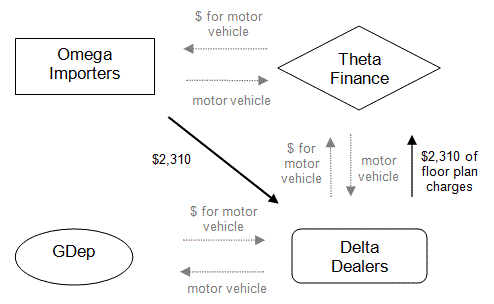
Is there a supply for consideration?
198. Delta Dealers does not make a supply for consideration to Omega Importers, as Delta Dealers does not do anything specific for Omega Importers.
Are there any adjustments under Division 134?
199. In this case, the allowance is paid specifically to compensate Delta Dealers for incurring the bailment charges while the vehicle is in GDep's possession, but before full payment is made. That is a cost incurred by Delta Dealers in relation to the acquisition of the motor vehicle by Delta Dealers from Theta Finance under the floor plan arrangement. The effect of the payment is that it indirectly reduces Delta Dealers' costs of acquiring the vehicle.
200. As Theta Finance and Omega Importers are members of the same GST group the supply of the motor vehicle by Omega Importers to Theta Finance is treated as if it were not a taxable supply under subsection 48-40(2). However, as the supply of the motor vehicle by Omega Importers to Theta Finance would have been a taxable supply if Omega Importers and Theta Finance were not in the same GST group (and Delta Dealers is not a member of the same GST group), subparagraph 134-5(1)(b)(ii) is satisfied.
201. Therefore, Omega Importers has a decreasing adjustment under section 134-5 and Delta Dealers has an increasing adjustment under section 134-10.
Demonstrator support payments
202. These payments are generally for holding a specified pool of demonstrator vehicles, and may compensate for costs dealers incur in holding that pool of demonstrator vehicles.
Worked Example 13: demonstrator support rebate
203. Under the dealership agreement, Kometkar Manufacturing requires its dealer, Titan Motors, to hold a certain number and range of demonstrator vehicles. Kometkar Pty Ltd makes a lump sum payment to Titan Motors for holding the required pool of demonstrator vehicles.
Is there a supply for consideration?
204. By holding the required pool of demonstrator vehicles, Titan Motors is making a supply to Kometkar Manufacturing, for which the payment is consideration.
205. Titan Motors is liable for GST on the supply it makes to Kometkar Manufacturing, and provided the other requirements for a creditable acquisition are satisfied, Kometkar Manufacturing has an input tax credit.
Are there any adjustments under Division 134?
206. As the payment is consideration for a supply made by Titan Motors to Kometkar Manufacturing, paragraphs 134-5(1)(e) and 134-10(1)(e) are not satisfied, there are no decreasing or increasing adjustments under Division 134.
Miscellaneous payments
Worked Example 14: dealer exclusively sells vehicles by manufacturer
207. Apollo Distributors manufactures a range of vehicles targeted exclusively at high end buyers. In order to maintain the exclusivity of the brand, Apollo pays a bonus to dealers who either only sell Apollo's vehicles, or those who have a dedicated standalone showroom for Apollo's vehicles. The payment is calculated at 1% of the dealer's yearly turnover.
208. Pan Motors is a dealer which sells vehicles from a range of manufacturers. However Pan Motors has a showroom which only displays Apollo's vehicles. Pan Motors' staff are not allowed to advertise or sell any other brand of vehicle from that showroom.
Is there a supply for consideration?
209. Pan Motors has made a supply of only selling Apollo Distributors' vehicles from that showroom for Apollo Distributors' payment.
210. As there is a supply for consideration, Pan Motors is liable to pay GST for that supply. Similarly, as Apollo Distributors has made a creditable acquisition, it may claim an input tax credit for that payment.
Worked Example 15: discounted servicing
211. Odin Manufacturing writes to existing customers who purchased their LOKI X model informing them that they are entitled to a free check-up and service at an authorised dealer. For customers that own the next generation LOKI XI models, Odin Manufacturing offers discounted check-up and service.
212. Customers can take up this offer by taking their vehicles into an authorised dealer. If the customer does so, Odin Manufacturing makes a payment to the dealer for each vehicle serviced representing all or part of the costs of servicing (as applicable).
213. Joanne owns a LOKI X and John owns a LOKI XI. Joanne and John both take up the offer and take their vehicles into Asgardian Motors, an authorised dealer.
Is there a supply for consideration?
214. In both cases, Asgardian Motors makes two supplies: one to Odin Manufacturing and one to Joanne and John. The first supply is a supply to Joanne and John of servicing the vehicle. Asgardian Motors also makes a supply to Odin Manufacturing of supplying the service to Joanne and John. This enables Odin Manufacturing to satisfy its obligation to Joanne and John.
215. In Joanne's case, the check-up and servicing is free, there is only one taxable supply made by Asgardian Motors even though there are still two supplies. This is because no consideration is provided by Joanne for the supply made to her. The taxable supply is the supply by Asgardian Motors to Odin Manufacturing, for which Odin Manufacturing pays the total costs of the service. See following diagram.
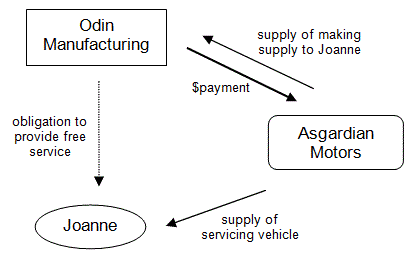
216. In John's case, the check-up and servicing is discounted, and there are two taxable supplies made by Asgardian Motors: the supply to John, for which John pays a discounted price, and the supply to Odin Manufacturing - for which Odin Manufacturing pays the remaining portion of the costs of the service. See following diagram.
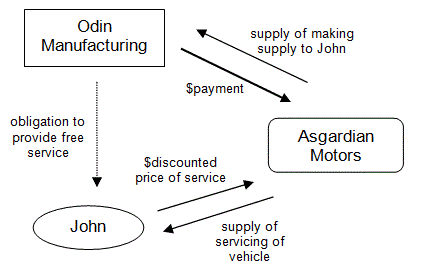
Date of effect
217. When the final Ruling is issued, it is proposed to apply to tax periods starting on or after 1 May 2014.
218. However, the Ruling will not apply to taxpayers to the extent that it conflicts with the terms of settlement of a dispute agreed to before the date of issue of the Ruling (see paragraphs 75 to 76 of Taxation Ruling TR 2006/10).
219. The Decision Impact Statement for AP Group explains the Commissioner's approach to compliance action in respect of earlier periods. The Commissioner invites comment on whether any further transitional arrangements are appropriate in implementing the final Ruling.
Commissioner of Taxation
23 April 2014
Appendix 1 - Explanation
 This Appendix is provided as information to help you understand how the Commissioner's preliminary view has been reached. It does not form part of the proposed binding public ruling.
This Appendix is provided as information to help you understand how the Commissioner's preliminary view has been reached. It does not form part of the proposed binding public ruling.
|
Supply by a dealer to a manufacturer for consideration
220. In AP Group, the Full Federal Court found that the overall business relationship between the manufacturer and the dealer involves 'a whole raft of obligations from one to the other all, presumably, with the ultimate objective of maximising their respective commercial positions' and which 'contemplates a continuing dialogue between wholesaler and retailer in which promises are routinely exchanged'.[36] In agreeing with the Tribunal's decision, the Court concluded that 'there is no supply of a service to the manufacturer by the dealer simply complying with those overall arrangements'.[37]
221. While the dealership agreement between a manufacturer and a dealer may contain any number of obligations by either party, this does not mean that all payments made by the manufacturer to the dealer will give rise to a supply to the manufacturer for consideration. Whether the dealer makes a supply for consideration is to be determined objectively in the facts and circumstances of each individual case.
222. An indicator that a payment is for conduct that is merely part of the overall business relationship is where it can be demonstrated that, regardless of the payment, the dealer would have conducted its business in the same way. As the Court explained in AP Group, in these cases, the dealer will always want to run its business in a certain way to sell as many vehicles as practicable and operate its business efficiently. If there is evidence to show that the dealer would otherwise conduct itself in the same way for free, then this may point towards the payment being part of the overall business relationship rather than for any specific supply by the dealer to the manufacturer.[38]
The supply can be in any form
223. Supply is defined broadly in subsection 9-10(1) to be 'any form of supply whatsoever'. For example, if the manufacturer pays the dealer to do something specific for it, the relevant supply is the supply of services provided by the dealer to the manufacturer.[39]
224. If the manufacturer pays the dealer for agreeing to do (or refraining from doing) something specific for the incentive payment, the relevant supply is the dealer's entry into an obligation to do (or refrain from doing) something.[40] The dealer may also make a supply of goods, or a supply in any other form, to the manufacturer.
Supply by a dealer to a retail customer for consideration (third party consideration)
225. There is a supply by the dealer to the customer for which the payment by the manufacturer is third party consideration, where the supply of the particular motor vehicle to the customer is the reason for the manufacturer making the payment to the dealer.[41]
226. In AP Group, the Court stated that the level at which the assessment of whether there is a supply for consideration should be undertaken varies depending on the facts.[42] Where the focus of the incentive payment is on the sale of a particular vehicle to a customer, then this would generally indicate that the payment is for, and in connection with, the supply of the vehicle to the customer.[43] In these circumstances, the dealer is generally not required or expected to do anything other than sell the vehicle and undertake the related actions (such as entering the sale into the relevant sale recording system) in order to receive the payment - it is the supply of the particular motor vehicle that is the reason for the manufacturer making the payment to the dealer.[44]
227. The timing of the payment is not determinative - consideration may be provided for a supply before or after a supply takes place,[45] and can be provided in several stages. An incentive payment may be consideration for a supply if it is for the inducement of a supply that has not yet been made, but is eventually made. If the reason for the payment is that eventual supply, then there will be a taxable supply for the purposes of paragraph 9-5(a).
Division 134 - third party payment adjustments
228. Division 134 applies to create adjustments for payers and payees in respect of certain third party payments made on or after 1 July 2010.
Dealer must acquire something that the manufacturer supplied to another entity (paragraphs 134-5(1)(a) and 134-10(1)(a))
229. Under paragraphs 134-5(1)(a) and 134-10(1)(a), the payment must be made to an entity (the payee) that acquires a thing that the payer supplied to another entity.
230. This requires there to be an acquisition of a thing by the dealer and a supply of a thing by the manufacturer. The term 'thing' is broadly defined in section 195-1 as 'anything that can be supplied or imported'. However, for the requirement to be satisfied the thing that the dealer acquired must be the same thing that the manufacturer supplied,[46] and the acquisition by the dealer must be from another entity in the supply chain rather than directly from the manufacturer.[47]
231. Under a typical floor plan arrangement, a dealer acquires a motor vehicle supplied by the manufacturer to the interposed finance company. In this context, the acquisition by a dealer of an individual vehicle will generally satisfy paragraphs 134-5(1)(a) and 134-10(1)(a).
232. Where the dealer acquires the thing directly from the manufacturer or where the dealer acquires the thing from another entity but the manufacturer never supplied that thing at any stage of the supply chain then the requirement of paragraphs 134-5(1)(a) and 134-10(1)(a) are not satisfied.
233. It is noted that an incentive payment that is made in situations where the dealer acquires the thing directly from the manufacturer may have consequences under the adjustment rules in Division 19.[48]
Payment must be made in connection with, in response to or for the inducement of the dealer's acquisition of the thing (paragraphs 134-5(1)(d)and 134-10(1)(d))
234. Under paragraphs 134-5(1)(d) and 134-10(1)(d), the payment must be made in connection with, in response to, or for the inducement of the payee's acquisition of the thing.
235. The language used in those paragraphs mirror the language used in subsection 9-15(1) which defines the term 'consideration'. The term 'consideration' is defined in subsection 9-15(1) to include, among other things, any payment in connection with, in response to or for the inducement of a supply of anything.
236. As discussed in other public rulings, whether a payment is 'consideration' under subsection 9-15(1) involves determining whether there is a sufficient nexus between a particular payment and a particular supply.[49] A tenuous or remote connection with a supply will not be enough to constitute consideration.[50]
237. Given the similarity in language used in subsection 9-15(1) and in paragraphs 134-5(1)(d) and 134-10(1)(d), principles relevant to determining whether there is a sufficient nexus in the context of subsection 9-15(1) as discussed in those public rulings may also be considered relevant in determining whether there is a sufficient nexus for adjustments under Division 134.
238. In determining whether there is a sufficient nexus, regard needs to be had to the true character of the transaction. An arrangement between parties will be characterised not merely by the description that parties give to the arrangement, but by looking at all of the transactions entered into and the circumstances in which the transactions are made.[51]
239. For the purpose of paragraphs 134-5(1)(d) and 134-10(1)(d), a payment may be consideration for a supply made by the dealer and also be in connection with the dealer's acquisition of a thing, if the payment relates to the acquisition of a particular thing .
Acquisition of a particular thing or particular things
240. The use of the words 'the thing' in paragraphs 134-5(1)(d) and 134-10(1)(d) indicate that for the paragraph to be satisfied, the third party payment must relate to the payee's acquisition of a particular thing or particular things, being the same thing or things that the payer supplied to another entity as identified under paragraphs 134-5(1)(a) and 134-10(1)(a).
241. The construction of paragraphs 134-5(1)(d) and 134-10(1)(d) and the method for calculating the amount of the adjustment indicate the payment must relate to the dealer's acquisition of a particular thing (or particular things) that the manufacturer supplied to another entity, and not simply to the dealer's general business operations.
242. Where the payment simply relates to the dealer's general business operations, the requirement of paragraphs 134-5(1)(d) and 134-10(1)(d) would not be satisfied.
243. The requirement that there be an acquisition of a particular thing (such as a particular motor vehicle or particular motor vehicles) is also reflected in the calculation of the amount of the decreasing adjustment and increasing adjustment under subsections 134-5(2) and 134-10(2) respectively, both of which require the 'consideration' for the taxable supply to be identifiable.
244. It follows that, in order to work out the amount of the decreasing or increasing adjustment, a particular thing, or particular things, must be identifiable.
Payment must relate to the dealer's acquisition of a particular thing
245. As the Full Federal Court stated in HP Mercantile Pty Limited v. Commissioner of Taxation [2005] FCAFC 126; (2005) 60 ATR 106; 2005 ATC 4571 (HP Mercantile), 'the words 'relates to' are wide words signifying some connection between two subject matters' and that 'the degree of relationship implied by the necessity to find a relationship will depend upon the context in which the words are found.'[52]
246. In the context of Division 134, an incentive payment will relate to the dealer's acquisition of a particular thing if the payment has the substantive effect of indirectly reducing the price of the thing acquired.
247. Contextual support for this can be found in subsection 134-5(2), which provides that the amount of the decreasing adjustment is equivalent to the difference between the amount of GST payable on the taxable supply made by the payer, and the amount of GST that would have been payable had the consideration for the supply been reduced by the amount of the payment made to the dealer.
248. Similarly, subsection 134-10(2) provides that the amount of the increasing adjustment is equivalent to the difference between the amount of the input tax credit for the payee's acquisition and the amount of the input tax credit if the consideration for the acquisition had been reduced by the amount of the payment.
249. The term 'price' is defined as the total consideration for a supply.[53] In effect, this means that the amount of an adjustment is calculated by reference to the 'original price' of the thing supplied by the manufacturer and acquired by the dealer, and what the price would have been had the manufacturer reduced the original price of the thing by the amount of the payment.[54]
250. Similarly, the amount of an increasing adjustment for a dealer (or GST registered customer, if applicable) is calculated by reference to the price paid for the acquisition of the thing by the dealer (original price) and what the price would have been had the original price been reduced by the amount of the payment.[55]
251. Further contextual support for this proposition can be found in paragraph 1.1 of the Explanatory Memorandum which states:
Schedule 1 to this Bill amends the A New Tax System (Goods and Services Tax) Act 1999 (GST Act) to ensure that the appropriate amount of goods and services tax (GST) is collected and the appropriate amount of input tax credits claimed in situations where there are payments between parties in a supply chain which indirectly alter the price paid or received by the parties for the things supplied. [emphasis added]
252. Paragraph 1.6 of the Explanatory Memorandum further explains that where the payment to the payee indirectly reduces the amount the payer receives for a supply, the payer will be entitled to a decreasing adjustment reflecting the difference between the GST remitted on the original supply and the GST which would have been payable on the supply if the consideration was calculated net of the third party payment. The payee will have an increasing adjustment if the acquisition was for a creditable purpose.
Appendix 2 - Summary of GST consequences for specific incentive payments
253. The tables below set out a summary of the GST consequences for manufacturers, dealers and GST registered customers in respect of specific incentive payments made under a bailment arrangement that are discussed in the Worked Examples.
254. The tables do not purport to be comprehensive as the GST consequences will depend on the relevant facts and circumstances. The tables should be read with this draft Ruling.
255. Note that in each case, the dealer is liable for GST on the supply of the motor vehicle and Division 19 adjustments are not discussed in these tables.
Guide to reading these tables
256. The tables that follow use the following acronyms:
| Acronym | Term |
|---|---|
| M | Manufacturer |
| D | Dealer |
| C | GST registered customer |
| ITC | Input tax credit |
|
|
Decreasing adjustment under section 134-5 |
|
|
Increasing adjustment under section 134-10 |
| Nil | No GST, ITC or adjustments under Division 134 |
Table 1: Supply by dealer to manufacturer for consideration (paragraphs 20 to 30 of the Ruling)
| Payment type | M | D | C | Relevant Example |
| Payments for services rendered to M (for example, preparing a vehicle for sale, installing or fitting parts to a vehicle) | ITC | GST | Ruling Examples 1 and 3
Worked example 15 |
|
| Payment for entering into a specific obligation | ITC | GST | Ruling Example 2 | |
| Payment for holding minimum pool of demonstrator vehicles
|
ITC | GST | Worked Example 13 | |
| Payment for agreeing to sell or promote only vehicles manufactured by M
|
ITC | GST | Worked Example 14 |
Table 2: Supply by dealer to retail customer for consideration (third party consideration) (paragraphs 31 to 46 of the Ruling)
| Payment type | M | D | C | Relevant Example |
| Fleet rebate paid to dealer
|
|
GST | Ruling Example 5
Worked Examples 1 and 2 |
|
| Fleet rebate paid to customer
|
|
|
Worked Example 3 | |
| Run-out model support payment paid to dealer
|
|
GST | Ruling Example 4
Worked Example 4 |
|
| Ex-demonstrator support payment
|
|
GST | Worked Example 5 |
Table 3: No supply for consideration (paragraphs 47 to 49 of the Ruling)
| Payment type | M | D | C | Relevant Example |
| Drive away price offers
|
|
|
Worked Example 6 | |
| Retail incentive paid per car
|
|
|
Worked Example 7 | |
| Retail incentive paid as a lump sum payment
|
|
|
Worked Example 7 | |
| Wholesale incentive paid per car
|
|
|
Worked Example 8 | |
| Wholesale incentive paid as a lump sum payment for acquiring
|
|
|
Worked Example 8 | |
| Payment for meeting standards
|
Nil | Nil | Worked Example 9 | |
| Transit/interest protection payment
|
|
|
Worked Examples 10 and 11 | |
| Delayed settlement allowance
|
|
|
Worked Example 12 | |
| Payment to reimburse dealer for general business expenses such as FBT where:
|
Nil | Nil | Ruling Example 6 |
Appendix 3 - Your comments
257. You are invited to comment on this draft Ruling including providing suggestions of any other types of incentive payments in the motor vehicle industry that should be covered and any suggested transitional arrangements. Please forward your comments to the contact officer by the due date.
258. A compendium of comments is prepared for the consideration of the relevant Rulings Panel or relevant tax officers. An edited version (names and identifying information removed) of the compendium of comments will also be prepared to:
- •
- provide responses to persons providing comments; and
- •
- be published on the ATO website at www.ato.gov.au.
Please advise if you do not want your comments included in the edited version of the compendium.
| Due date: | 6 June 2014 |
| Contact officer details have been removed following publication of the final ruling. | |
Appendix 4 - Detailed contents list
259. The following is a detailed contents list for this Ruling:
| Paragraph | |
| What this draft Ruling is about | 1 |
| Background | 8 |
| Acquisition of motor vehicles under floor plan arrangements | 8 |
| The AP Group decision | 13 |
| Implementing the AP Group decision | 17 |
| Ruling | 19 |
| Supply by a dealer to a manufacturer for consideration | 20 |
| Example 1: supply to manufacturer for consideration | 21 |
| Example 2: supply of entry into contractual obligation for consideration | 24 |
| Dealer's conduct giving rise to a specific supply to the manufacturer | 26 |
| Example 3: specific supply to manufacturer for consideration | 27 |
| Supply by a dealer to a retail customer for consideration (third party consideration) | 31 |
| Example 4: dealer makes supply for consideration to customer only | 34 |
| Example 5: third party consideration | 42 |
| No supply for consideration | 47 |
| Example 6: no supply for consideration | 48 |
| Division 134 - third party payment adjustments | 50 |
| Decreasing adjustments | 51 |
| Increasing adjustments | 54 |
| Dealer must acquire something that the manufacturer supplied to another entity (paragraphs 134 5(1)(a) and 134-10(1)(a)) | 56 |
| Dealer must actually acquire the thing | 58 |
| Example 7: payment for which there is no acquisition of a thing | 62 |
| Payment must be made in connection with, in response to or for the inducement of the dealer's acquisition of the thing (paragraphs 134-5(1)(d) and 134-10(1)(d)) | 65 |
| Acquisition of a particular thing or particular things | 68 |
| Payment must relate to the dealer's acquisition of a particular thing | 71 |
| Example 8: payment made for dealer's acquisition of specified number of vehicles | 74 |
| Example 9: general support payment | 76 |
| Payment must not be consideration for a supply (paragraphs 134-5(1)(e) and 134-10(1)(e)) | 78 |
| Example 10: incentive payment is consideration for a supply to the manufacturer | 80 |
| Example 11: incentive payment is consideration for a supply to a third party | 82 |
| Worked Examples | 86 |
| Third party adjustment notes | 87 |
| Approved form | 89 |
| Information requirements in the legislative instrument | 92 |
| Clearly ascertained | 93 |
| Circumstances in which the Commissioner may exercise the discretion to treat a document as a third party adjustment note | 95 |
| Worked examples 99 | |
| Fleet rebates | 101 |
| Worked Example 1: fleet rebate paid to dealer for vehicle acquired as non-fleet vehicle | 103 |
| Is there a supply for consideration? | 107 |
| Are there any adjustments under Division 134? | 112 |
| Worked Example 2: fleet rebate paid to a dealer before sale to customer | 117 |
| Is there a supply for consideration? | 120 |
| Are there any adjustments under Division 134? | 122 |
| Worked Example 3: fleet rebate paid to customer | 125 |
| Run-out model incentive payments | 129 |
| Worked Example 4: run out model incentive payment | 130 |
| Worked Example 5: incentive payment for the sale of ex-demonstrators | 137 |
| Driveaway support payments | 143 |
| Worked Example 6: driveaway prices | 145 |
| Volume targets | 153 |
| Worked Example 7: retail target incentive payment | 154 |
| Worked Example 8: wholesale target incentive payment | 161 |
| Performance targets not related to motor vehicles | 169 |
| Worked Example 9: payment for meeting standards | 170 |
| Incentive payments made to reimburse dealer for the cost of incurring financing and bailment charges | 177 |
| Worked Example 10: delivery allowance | 180 |
| Worked Example 11: pre-delivery allowance | 188 |
| Worked Example 12: settlement delay allowance | 193 |
| Demonstrator support payments | 202 |
| Worked Example 13: demonstrator support rebate | 203 |
| Miscellaneous payments | 207 |
| Worked Example 14: dealer exclusively sells vehicles by manufacturer | 207 |
| Worked Example 15: discounted servicing | 211 |
| Date of effect | 217 |
| Appendix 1 - Explanation | 220 |
| Supply by a dealer to a manufacturer for consideration | 220 |
| The supply can be in any form | 223 |
| Supply by a dealer to a retail customer for consideration (third party consideration) | 225 |
| Division 134 - third party payment adjustments | 228 |
| Dealer must acquire something that the manufacturer supplied to another entity (paragraphs 134 5(1)(a) and 134-10(1)(a)) | 229 |
| Payment must be made in connection with, in response to or for the inducement of the dealer's acquisition of the thing (paragraphs 134-5(1)(d)and 134-10(1)(d)) | 234 |
| Acquisition of a particular thing or particular things | 240 |
| Payment must relate to the dealer's acquisition of a particular thing | 245 |
| Appendix 2 - Summary of GST consequences for specific incentive payments | 253 |
| Appendix 3 - Your comments | 257 |
| Appendix 4 - Detailed contents list | 259 |
© AUSTRALIAN TAXATION OFFICE FOR THE COMMONWEALTH OF AUSTRALIA
You are free to copy, adapt, modify, transmit and distribute this material as you wish (but not in any way that suggests the ATO or the Commonwealth endorses you or any of your services or products).
Footnotes
ATO ID 2008/166: GST and motor vehicle industry incentive payments: fleet sales support - margin support - discretionary payments, which was withdrawn on 25 October 2013.
See Goods and Services Tax Determination GSTD 2005/4 Goods and services tax: are 'wholesale holdback' and 'retail holdback' payments made by a motor vehicle manufacturer or importer of new motor vehicles to a dealer consideration for a supply?
See paragraphs 221A to 221S of GSTR 2006/9 Goods and services tax: supplies.
AP Group at [40] and [44]. The Full Federal Court found that 'the lack of knowledge of the fleet customer of the arrangements between Toyota and the dealer is one factor only but cannot be determinative on the facts overall'.
See GSTR 2013/1 Goods and services tax: tax invoices for further discussion on the information requirements for a tax invoice
Paragraph 11-5(b).
See paragraphs 50 to 85 for a discussion on the application of Division 134 to incentive payments.
Paragraph 11-30(1)(b).
See section 40-230 of the Income Tax Assessment Act 1997. The car limit is different to the luxury car tax threshold.
See GSTR 2000/19 Goods and services tax: making adjustments under Division 19 for adjustments events.
See paragraph 50 to 85 for a discussion on the application of Division 134.
Item 29 in Schedule 1 to the Tax Laws Amendment (2010 GST Administration Measures No. 1) Act 2010.
Paragraph 134-5(1)(a).
Paragraph 134-5(1)(b).
Paragraph 134-5(1)(c).
Paragraph 134-5(1)(d).
Paragraph 134-5(1)(e).
Paragraph 134-10(1)(a).
Paragraph 134-10(1)(b).
Paragraph 134-10(1)(c).
Paragraph 134-10(1)(d).
Paragraph 134-10(1)(e).
Paragraphs 134-5(1)(a) and 134-10(1)(a).
A decreasing adjustment is not attributable until the manufacturer holds a third party adjustment note: subsection 134-15(1).
Paragraph 134-5(1)(e).
Paragraph 134-10(1)(e).
Subsection 134-15(1).
Subsection 134-20(2).
The Commissioner has determined the other information that a third party adjustment note must contain in A New Tax System (Goods and Services Tax) Third Party Adjustment Note Information Requirements Determination (No. 1) 2010.
This Ruling constitutes approval in writing by the Commissioner under subsection 388-50(1) of Schedule 1 to the Taxation Administration Act 1953 (TAA 1953) for such documents to be in an approved form for third party adjustment notes.
This record must be in English or readily accessible and easily convertible to English as required by subsection 382-5(8) of Schedule 1 to the TAA 1953.
Paragraph 134-20(1)(c) provides that the third party adjustment note must set out the payer's ABN.
Further explanation of some of these information requirements is set out in GSTR 2013/2 Goods and services tax: adjustment notes in respect of adjustment notes for Division 19 adjustments.
Subsection 134-20(1).
See paragraph 29 of GSTR 2000/29 Goods and services tax: attributing GST payable, input tax credits and adjustments.
AP Group at [53].
AP Group at [49].
AP Group at [53].
Paragraph 9-10(2)(b).
Paragraph 9-10(2)(g).
AP Group at [44].
AP Group at [43].
AP Group at [43], Edmonds and Jagot JJ note that '[t]he appropriate level for the assessment is the particular supply of the car in question by the dealer and the payment which that supply triggers'.
AP Group at [44].
See subsection 9-15(1), which defines 'consideration' to include 'any payment [...] in connection with a supply of anything' and 'any payment [...] in response to or for the inducement of a supply of anything'.
Explanatory Memorandum to the Tax Laws Amendment (2010 GST Administration Measures No. 1) Bill 2010 (Explanatory Memorandum) at [1.8].
Explanatory Memorandum at [1.2].
See GSTR 2000/19.
Paragraph 50 of GSTR 2001/6 and paragraph 75 of GSTR 2001/4.
AP Group at [35].
Paragraph 71 of GSTR 2001/6 and paragraph 96 of GSTR 2001/4.
HP Mercantile at [35].
Subsection 9-75(1).
Subsection 134-5(2).
Subsection 134-10(2).
There must be an acquisition.
There must be an acquisition.
There must be an acquisition.
There must be an acquisition.
There must be an acquisition.
There must be an acquisition.
There must be an acquisition.
There must be an acquisition.
Not previously issued as a draft
References
ATO references:
NO 1-58W51ZR
Related Rulings/Determinations:
TR 2006/10
GSTR 2000/19
GSTR 2000/29
GSTR 2001/4
GSTR 2001/6
GSTR 2006/9
GSTR 2012/2
GSTD 2005/4
GSTR 2013/1
GSTR 2013/2
Subject References:
creditable acquisition
decreasing adjustment
GST
Increasing adjustment
input tax credit
motor vehicle incentives
supply for consideration
taxable supply
third party adjustment
third party adjustment note
third party consideration
Legislative References:
ANTS(GST)A 1999 9-5
ANTS(GST)A 1999 9-5(a)
ANTS(GST)A 1999 9-10(1)
ANTS(GST)A 1999 9-10(2)(b)
ANTS(GST)A 1999 9-10(2)(g)
ANTS(GST)A 1999 9-15
ANTS(GST)A 1999 9-15(1)
ANTS(GST)A 1999 9-75(1)
ANTS(GST)A 1999 11-5
ANTS(GST)A 1999 11-5(b)
ANTS(GST)A 1999 11-30(1)(b)
ANTS(GST)A 1999 Div 19
ANTS(GST)A 1999 29-70
ANTS(GST)A 1999 29-75
ANTS(GST)A 1999 54-50(1)
ANTS(GST)A 1999 69-10
ANTS(GST)A 1999 Div 134
ANTS(GST)A 1999 134-5
ANTS(GST)A 1999 134-5(1)
ANTS(GST)A 1999 134-5(1)(a)
ANTS(GST)A 1999 134-5(1)(b)
ANTS(GST)A 1999 134-5(1)(b)(ii)
ANTS(GST)A 1999 134-5(1)(c)
ANTS(GST)A 1999 134-5(1)(d)
ANTS(GST)A 1999 134-5(1)(e)
ANTS(GST)A 1999 134-5(2)
ANTS(GST)A 1999 134-5(3)(a)
ANTS(GST)A 1999 134-10
ANTS(GST)A 1999 134-10(1)
ANTS(GST)A 1999 134-10(1)(a)
ANTS(GST)A 1999 134-10(1)(b)
ANTS(GST)A 1999 134-10(1)(c)
ANTS(GST)A 1999 134-10(1)(d)
ANTS(GST)A 1999 134-10(1)(e)
ANTS(GST)A 1999 134-10(2)
ANTS(GST)A 1999 134-15(1)
ANTS(GST)A 1999 134-20(1)
ANTS(GST)A 1999 134-20(1)(c)
ANTS(GST)A 1999 134-20(2)
ANTS(GST)A 1999 195-1
ITAA 1997 40-230
TAA 1953 Sch 1 382-5(6)
TAA 1953 Sch 1 388-50(1)
Tax Laws Amendment (2010 GST Administration Measures No. 1) Act 2010 item 29
Case References:
AP Group v. Commissioner of Taxation
(2013) 214 FCR 301
[2013] FCAFC 105
2013 ATC 20-417
A.P. Group Limited v. Commissioner of Taxation
[2012] AATA 409
(2012) 83 ATR 493
2012 ATC 10-256
HP Mercantile Pty Limited v. Commissioner of Taxation
[2005] FCAFC 126
(2005) 60 ATR 106
2005 ATC 4571
Other References:
A New Tax System (Goods and Services Tax) Third Party Adjustment Note Information Requirements Determination (No. 1) 2010
ATO ID 2008/166
Explanatory Memorandum to the Tax Laws Amendment (2010 GST Administration Measures No. 1) Bill 2010
PS LA 2004/11
Copyright notice
© Australian Taxation Office for the Commonwealth of Australia
You are free to copy, adapt, modify, transmit and distribute material on this website as you wish (but not in any way that suggests the ATO or the Commonwealth endorses you or any of your services or products).


